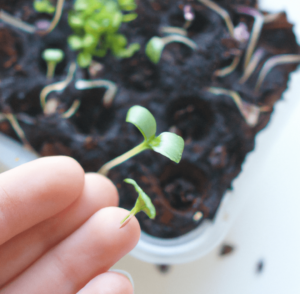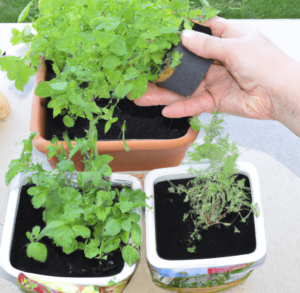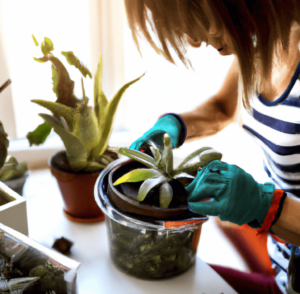For many gardeners, beginning a garden is a joyful and rewarding experience, but what if you just have a small amount of space? This shouldn’t stop you from learning how to start a garden in an apartment. For anyone wanting to learn how to start a garden in a small space, here’s what you need to know!
Planning and Preparation
Gardeners should spend the necessary time planning and getting ready before beginning a garden. Learning how to start a garden in a small space means:
- Choosing the correct soil and containers, as well as selecting the best variety for your region and the amount of sunlight your garden receives, are all parts of this process.
- Picking what kinds of vegetables, plants, and flowers you want to grow.
- Decide the shape and placement of your garden by making a plan, and you can make sure there is enough room for all of your plants.

Assessing the Available Space
Before learning how to start a garden in a small space, you need to assess the available space you have which includes checking on the state of the soil, sunshine accessibility, and the availability of water supplies in the potential garden area.
In order to make sure there is adequate space for all of the plants in their garden, gardeners should also take into account how much area each variety of plant will require to grow effectively.
Identifying the Best Location for a Garden
Learning how to start a garden in a small space is looking for the best possible location around your home. The garden should ideally receive six hours or more of direct sunlight each day, however, this can change based on the needs of the particular plants you have selected.
While some gardeners choose to use a patio or balcony, others may choose to use a tiny area of their yard that was used after learning how to grow plants in extreme climates. To make sure your plants get adequate light, wherever you decide to put them, it’s vital to consider the size of the space and the area’s exposure to sunlight.
Choosing the Right Plants for a Small Space
It’s crucial to think about both beauty and utility when selecting plants for a tiny area, such as a patio, balcony, or windowsill. While you’re learning how to start a garden in a small space, you want them to look great but thrive too:
- Choose small flower species that carry a punch if you’re after color. Great choices that come in a range of hues and bloom all during the growing season include petunias, pansies, and impatiens.
- If you like herbs, you might choose to plant basil, chives, or parsley because they are not only good for cooking but also beautiful and aromatic.
- Succulents, cacti, and herbs are among the plants that do best in sunny locations, whereas ferns need low light levels.
Designing the Garden
Now that you’ve got an introduction to how to start a garden in a small space, we’re moving on to the designing phase:
- Make a plan: Spend some time considering the style and goals you want for your garden before you start purchasing plants and accessories. To help you visualize the space, you can either draw out your ideas on paper or utilize a garden design tool.
- Use vertical space to your advantage: When you’re short on horizontal space, you can maximize what you have by using vertical space. To make additional space for plants, construct shelves or hang pots from hooks.
- Choose things with several uses: Choose products that have several uses when space is at a premium. For instance, you can utilize a bench as both a lounging space and a location to keep gardening tools and materials.
- Try experimenting with different textures and heights to create a visually appealing garden. To give your space depth and dimension, use low-growing ground covers, towering blooming plants, and everything in between.
Don’t forget to add accessories, such as lighting, birdhouses, and wind chimes, to complete your garden. These accents can contribute to a warm and welcoming ambiance.
Creating a Layout Plan
If you want to cultivate veggies in your small garden, learning how to grow plants in a small space is making a layout plan:
- Choose a site for your garden that receives at least 6 hours of sun per day. Determine the sun exposure. For many vegetable crops to grow and prosper, this is essential.
- Sketch out on paper the dimensions of the space you have set aside for your garden. This can help you plan more effectively by giving you a better understanding of the available area.
- Consider companion planting and pairing veggies and herbs together. For instance, basil and tomatoes go well together since basil is said to improve the flavor of the tomatoes.
- Tall crops should be planted towards the back of your garden, and shorter crops should be planted in the front. This will ensure that all of the plants get enough sun exposure and help avoid the taller plants from shading the shorter ones.
- If you intend to grow vegetables, take soil fertility into account. Choose fertile, well-draining soil. If the soil in your location is not the best, think about enhancing its fertility by adding compost or other organic matter.
- Due to their relative compactness and ability to yield a lot of food in a little area, cole crops, such as broccoli, cauliflower, and cabbage, are excellent choices for tiny gardens.
Using Vertical Gardening Techniques
If your horizontal spaces are restricted, you can still learn how to start a garden in a small space with vertical gardening:
- Use trellises: Growing climbing plants like beans, peas, and squash vertically is a terrific idea when using trellises. All you need to do is fasten a trellis to a wall or fence and train the plants to climb it.
- Install hanging baskets: Growing herbs and other tiny plants in a small garden using hanging baskets is a terrific idea. To make watering simpler, choose baskets with integrated irrigation systems.
- Use wall planters: A variety of plants, including herbs and succulents, can be grown in wall planters. To save important garden floor areas, these pots can be placed on walls or fences.
- Consider growing plants in tiers if you have little available horizontal space. To maximize growth area, this entails stacking pots or planters on top of one another.
- Utilize vertical garden systems: There are many different types of vertical garden systems, from stacking pots to modular wall systems. These systems can be tailored to meet your own requirements and tastes and can be used to cultivate a variety of plants in a small garden.
Incorporating Container Gardening
Learning how to start a garden in a small space is made a lot easier with container gardening:
- Select the proper container: Make sure the container you choose has enough drainage and is the proper size for the plant you wish to grow. Although plastic containers are lighter and sometimes easier to move around than terra cotta pots, they are less common.
- Choose veggies that do well in containers: Tomatoes, lettuce, and herbs are a few plants that do well in containers. Pick plants that are suitable for your container’s size and your gardening objectives.
- Use the correct soil: When filling your containers, be sure to use potting soil of the highest caliber. Your plants will develop in the finest conditions possible, and you’ll make sure they get the nutrients they need to prosper.
- Use self-watering containers as a possibility: Use self-watering pots if you’re concerned about watering your container plants. These containers have an integrated reservoir that will water your plants automatically as needed.
- Pay attention to the light: Make sure your container garden is situated where it will receive enough sunlight. This will make it more likely that your plants will get the light they require to develop and bear fruit.
You can expand the range of veggies, herbs, and other plants you can grow in your tiny garden with this type of gardening.

Soil and Water
Whether it’s a vegetable garden, a container garden, or a mixed planting, soil, and water are two of the most crucial elements in maintaining the health and success of your garden:
- Testing: Test your soil before you start planting to find out its pH and nutrient levels. This will enable you to decide whether any amendments are required to provide the ideal growing environment for your plants.
- Pick the proper soil: Use top-notch, well-draining soil that is abundant in organic matter. Choose the proper soil for your unique needs because container gardens will need a different soil mix than in-ground gardens.
- Be water-wise: Don’t over or underwater your plants; just water them regularly. In comparison to in-ground gardens, container gardens may need more frequent watering. To make sure your plants get the appropriate amount of water, think about creating a watering schedule or using a self-watering container.
Preparing the soil
As you learn how to start a garden in a small space, you will also learn how to prepare the soil:
- Test your soil before you start planting to find out its pH and nutrient levels. This will enable you to decide whether any amendments are required to provide the ideal growing environment for your plants.
- Adding organic matter, such as old manure or compost, will aid your soil’s structure and encourage the growth of healthy roots.
- You may need to add lime or sulfur to your soil to bring the pH level to one that is suitable for your plants if it is too high or low.
- If your soil is weak or compacted, take into account planting in raised beds. This will let you make a special soil blend that is perfect for your plants and can enhance drainage.
Choosing the Right Soil and Fertilizers
Your success as a gardener after learning how to start a garden in a small space can depend on whether or not you choose the right soil and fertilizer:
- Be sure to select high-quality, well-draining soil that is rich in organic matter. Your plants will develop in the greatest conditions possible, and this will help to guarantee they get the nutrients they need to thrive.
- Test your soil before you start planting to find out its pH and nutrient levels. This will enable you to decide whether any amendments are required to provide the ideal growing environment for your plants.
- Consider using raised beds if your garden has poor soil or a little amount of area. This will let you make a special soil blend that is perfect for your plants and can enhance drainage.
- Be careful to give your plants a balanced fertilizer, such as a 10-10-10 formula, on a regular basis. To give a natural source of nutrients, take into consideration using organic fertilizers like aged manure or compost.
Managing Water Effectively
You can learn how to start a garden in a small space by using this watering guide:
- Proper drainage: The ideal location for your vegetable garden should receive sufficient sunlight and have appropriate drainage.
- Watering regularly: Watering regularly is crucial for the health of your plants. Regularly water your plants, but watch out not to overwater or underwater them. To save water and reduce waste, think about utilizing a soaker hose or a drip irrigation system.
- Mulch: Covering your soil’s surface with mulch will help it retain moisture and lessen evaporation.
- If at all possible, water your plant’s first thing in the morning. This will decrease the likelihood of fungal illnesses by giving the leaves time to dry out before dusk.
- If you are in a region with variable rainfall, you might want to think about capturing rainwater for your garden. This can aid in water conservation and ease the burden on your community’s water supplies.
Maintenance and Care
Make sure everything you’ve learned in the gardening guide of how to start a garden in a small space doesn’t go to waste:
- Regular maintenance can assist encourage healthy growth and stop the spread of illness. This can be done by routinely removing dead or yellowing leaves as well as spent blooms from flowering plants.
- Consider adopting natural approaches, like companion planting and organic insecticides, to combat pests and illnesses.
- Optimum spacing is important to allow for proper airflow and avoid overcrowding when planting your herbs and veggies.
- A key factor in ensuring the success of your plants is knowing when to harvest them. The majority of vegetables and herbs should be picked at their optimum, just before they start to deteriorate.
The secret to cultivating healthy and fruitful plants, whether you have a huge garden or a little container garden, is maintenance and care. You may make sure that your herb and vegetable garden prospers by paying attention to the advice given here.
Bottom Line: How to Start a Garden in a Small Space
Learning how to start a garden in a small space can be a rewarding and joyful experience for any gardener. You can transform your modest outdoor space into a thriving garden full of a variety of vegetables and plants by selecting the correct plants, preparing the soil, managing water efficiently, and maintaining and caring for your garden.
FAQs on How to Start a Garden in a Small Space
What should you do when you’re starting to learn how to start a small garden?
Before starting a garden, the first step is to plan and make preparations. The best plants for your area and the amount of sunlight should be chosen, along with the right soil and containers, and a plan should be made for the size and location of your garden.
What elements should be taken into account when determining the amount of garden area that is available?
Gardeners should think about the soil’s condition, how much sunlight the garden will receive, and the availability of water sources while evaluating the space they have available. They should also consider how much room each type of plant will need to flourish successfully.
Where would be the best place for a tiny garden?
A small garden should be placed in an area that receives at least six hours of direct sunlight every day, however, this can change depending on the demands of the specific plants being produced.
What factors should be taken into account when selecting plants for a small garden?
It’s crucial to take both aesthetics and practicality into account when selecting plants for a small garden. Plants should be chosen by gardeners based on their aesthetic preferences and their ability to grow in the given conditions.
What advice would you give someone to create a small garden?
Make a layout, use vertical space, select items with multiple purposes, and experiment with various textures and heights, adding accessories, employing low-growing ground covers, and towering blooming plants.
What are the essential components for successfully managing a garden?
Two of the most crucial elements in guaranteeing the health and prosperity of your garden are the soil and the water.
How do I examine my soil prior to planting?
Test your soil to find out its pH and nutrient levels prior to planting. This will enable you to decide whether any adjustments are required to give your plants the best possible growing environment.
How should I prepare the soil for my garden?
Use organically rich, high-quality soil that drains properly. Pick the right soil for your unique needs because different garden varieties may call for different soil mixtures.
How frequently should I water my plants?
Regularly water your plants, but be out not to drown them or overwater them. Compared to in-ground gardens, container gardens might require more frequent irrigation.
Which fertilizers are best for my veggie garden?
Regularly apply a balanced fertilizer, such as one with a 10-10-10 composition. If you’re looking for a natural source of nutrients, think about employing organic fertilizers like compost or aged manure.
How can I successfully manage water for my vegetable garden?
Your garden’s optimal site needs to have adequate drainage and sunlight exposure. Regularly water your plants, but be out not to drown them or overwater them. To save water, think about utilizing a soaker hose or a drip irrigation system. Mulch applied to the soil’s surface will aid in moisture retention and lessen evaporation. If at all possible, water your plants in the morning to lower the danger of fungus illnesses. In areas with inconsistent rainfall, think about collecting rainwater for your garden.
What upkeep and attention do I need to provide my herb and veggie garden?
In order to promote healthy growth and stop the spread of disease, routine care is crucial. Regularly remove wasted blossoms and foliage that have turned yellow or dead.
To tackle pests and illnesses, take into account employing natural techniques like companion planting and organic insecticides. For optimum ventilation and to avoid crowding, ideal spacing is crucial.







